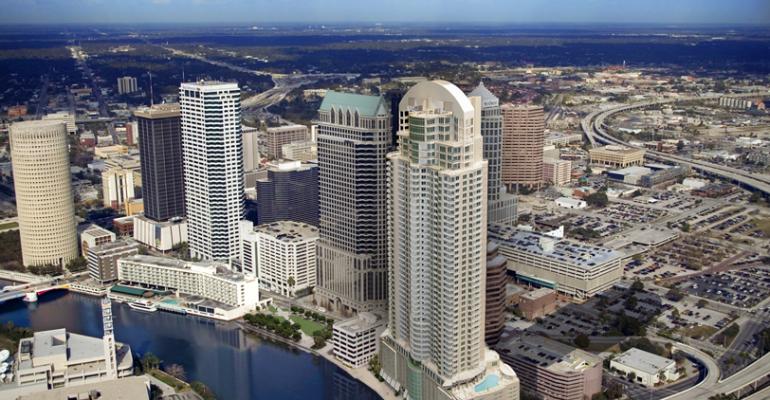Some real estate investors are under the impression that New Markets Tax Credits (NMTC) are only for severely blighted areas. But that’s not the case: the credits can be used in “distressed” areas that often include up-and-coming parts of town.
In Florida alone, NMTCs have been used in Florida communities like Tampa, Riviera Beach, Fort Lauderdale and Fort Myers.
Projects that provide 40 percent of their service to a nearby low-income neighborhood, have as little as 40 percent of their tangible property located in a low-income neighborhood or generate 50 percent of their gross income in a low-income neighborhood could all qualify.
Because of the variety of ways that a project can qualify, NMTCs have been used in many economically stable communities. For example, on the downtown Tampa waterfront, $10 million in NMTCs played a significant part in Tampa Bay Lightning owner Jeff Vinik’s revitalization of Amalie Arena, the National Hockey League team’s home.
In 2016, the City of Riviera Beach used $6.9 million in NMTCs to help redevelop a local marina as part of a larger redevelopment project. The new Riviera Beach Marina Village includes an events center, a two-story restaurant with indoor-outdoor seating, a rooftop patio overlooking the water, a bicentennial park, a year-round public market and a mixed-use building with hotel, parking, offices and retail.
Last December, a $10 million NMTC project was announced to restore a historic Atlantic Coast Line railroad station in downtown Fort Myers. The project, a public-private partnership involving the City of Fort Myers and the Southwest Florida Community Foundation, will restore the train station while constructing a state-of-the-art 10,000-sq.-ft. LEED Gold-certified shared office space property. The NMTC provided $3 million in equity-like financing for the overall project.
The NMTC is unique among tax credit programs in that it creates incentives for investors to provide project funding in exchange for tax credits. This incentive generates favorable loan terms with equity infusion that becomes available to the project after a seven-year compliance period. This makes it an excellent tool when capital is needed for start-up costs, as well as construction financing.
Here are answers to seven questions about NMTCs that are often asked by property owners:
Q: What is the history behind NMTCs?
A: The NMTC program was authorized in the Community Renewal Tax Relief Act of 2000, designed to encourage private investment in areas that were traditionally underserved by the business lending and investment community.
Q: Where can NMTCs be used?
A: NMTCs are eligible for use nationwide in designated low-income communities. Low-income communities are geographic areas where, according to census data, the poverty rate is 20 percent or more, and the median family income does not exceed 80 percent of the metropolitan area or state [median income]. Also, areas of particular need are sometimes designated by the federal government.
Q: What kinds of projects are NMTCs usually used for?
A: Any operating business, including a real estate developer, can receive the benefits of NMTCs. NMTCs have been used in a wide variety of projects, including repurposing historical buildings, bringing health care services to new areas, providing charter schools, manufacturing facilities and facilities used by tax exempt organizations. Public projects can benefit as well, such a public marinas, aquariums and sporting facilities.
Q: How do the tax credits work as part of the funding for a project?
A: Investors receive a tax credit equal to 39 percent of the total cash investment. In turn, a community development entity holds the tax credits and uses the cash equity to fund a loan to a qualified borrower. In exchange, the borrower receives a low interest loan for seven years, at the end of which the borrower receives an equity-equivalent investment of between 20 and 25 percent of the total loan amount.
Q: Are there any risks associated with the program?
A: The qualified borrower, known as a “qualified active low-income community business,” must maintain its qualifications for the entire seven-year loan period or face liability for a recapture of the NMTCs by the investor. Fortunately, qualified borrowers would have to almost go out of their way to cease being qualified borrowers during the seven-year period.
Q: What types of businesses qualify?
A: In general, any trade or business receiving NMTCs for a project must do about 40 percent of its business in, or have 50 percent of its gross income come from, businesses located in a low-income area, as identified by census data.
Specifically, eligible NMTC projects must have at least one of the following: 50 percent of gross income from business located in a low-income community; 40 percent of tangible property used in a low-income community or 40 percent of services delivered to a low-income community.
Q: What has the impact been to communities that have used NMTCs?
A: Between 2003 and 2015, $42 billion in direct NMTC investments were made in businesses, and these investments leveraged nearly $80 billion in total capital investment for business and revitalization projects.
Bob Reid, attorney at the Bryant Miller Olive law firm, has over 35 years of experience in financial transactions and tax planning, and has focused exclusively on tax-exempt and taxable financing since 1985. Reid serves as the chair of the law firm’s affordable housing and New Markets Tax Credits practice areas.

